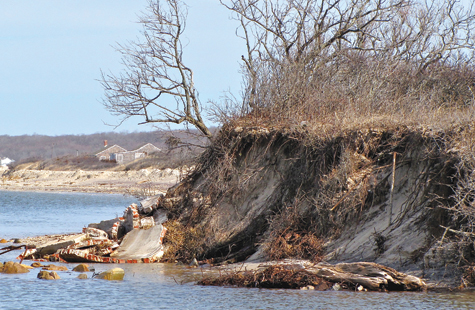The unexpected result of Goldsmith Inlet dredging

Last year’s dredging of Goldsmith Inlet in Peconic was engineered to keep the perennially clogged waterway open longer than previous projects by deepening the channel.
But the change in the dredging, combined with ongoing erosion to the east of the inlet, appears to have far surpassed expectations, and the mouth of the inlet is now wider than at any time in recent memory.
But that’s not necessarily a good thing.
Robert Dunn and his neighbors, who live just west of the inlet, fear that the waterway will overflow its banks into the parking lot at the end of Mill Lane on the inlet’s west side. Meanwhile, on the opposite shore, erosion has removed the sandy beach and waves are digging into the dune, causing the collapse of an old brick and cement cistern. The tides have also ripped out small trees.
The inlet’s east side has long been susceptible to erosion, a problem tied to the natural flow of sand parallel to the beach, known as the littoral drift. The natural west-to-east flow is interrupted by the Goldsmith Inlet jetty — and that leads to the scouring of the down-drift beach to the east.
During the Southold Town Board’s Feb. 14 meeting, Mr. Dunn brought a painting of the inlet by local artist Lee Harned showing the waterway as it used to be, with the sandy beach and dune, atop which sat a lone iconic tree.
“Any 4-year-old knows when you dig a hole in the sand, it collapses,” he said. “It’s just going to come in from the sides and cave in.”
Neighbor Lillian Ball, who initially suggested the town hire a firm that recommended the deeper dredging as a stop-gap measure until a scientific study of the inlet was conducted, said it’s very upsetting to see how quickly the eastern shore is eroding, particularly during a winter that has so far seen none of the nor’easters storms that caused much damage in previous years.
Ms. Ball said that, while the entrance to the inlet is wider than in the past, it may not be helping the tidal flushing of the inlet, because the water is still very shallow because of sand that comes in around the jetty.
“The flow is not necessarily improved by a wider mouth” of the inlet, she said. “Nobody really knows what’s happening. We need hydrological engineers to look at it. There’s never been assessment of the interior of the inlet.”
A Suffolk County-funded project by Cornell Cooperative Extension slated to begin this spring should do just that, she said.
Mr. Dunn convinced the town earlier this winter to stockpile revetment stones at the highway yard to place alongside the town parking lot if the tide begins to flood the area. He’s also endeavored to convince the town to develop plans for permanently shoring up the beach adjacent to the parking lot on the west side of the inlet.
Supervisor Scott Russell said on Feb. 14 that the erosion may prompt the town to reconsider the highly contentious question of what changes, if any, should be made to the jetty. The town previously suggested a plan to shorten the jetty by a third, but that drew swift and vehement opposition from residents in a cluster of houses just west of the jetty. They fear the loss of even a part of the stone jetty could threaten their homes.
Town officials have long maintained that the last third of the jetty is in serious disrepair, and sand easily passes between the rocks straight into the inlet.
In September 2010, the Town Board declined to do an environmental impact study on shortening the jetty by a third.
Mr. Russell was the only member of the board to support the proposal at that time. Other board members expressed concern about the project’s cost and effectiveness.
Mr. Dunn argues that the jetty is building up the beach for only 10 or 12 houses.
“If you take the jetty down, the high tide line is going to move back to their houses,” he said. “But you can’t protect the few at the expense of the rest.”
Ms. Ball said she and other members of the Group to Save Goldsmith Inlet have long remained neutral on what to do about the jetty.
“I truthfully don’t know what the best solution is,” she said. “That’s why we want professionals to look at it. You’ve got to have a community that’s behind finding a solution. It’s extremely important we come to a solution that’s not a Band-Aid.”








